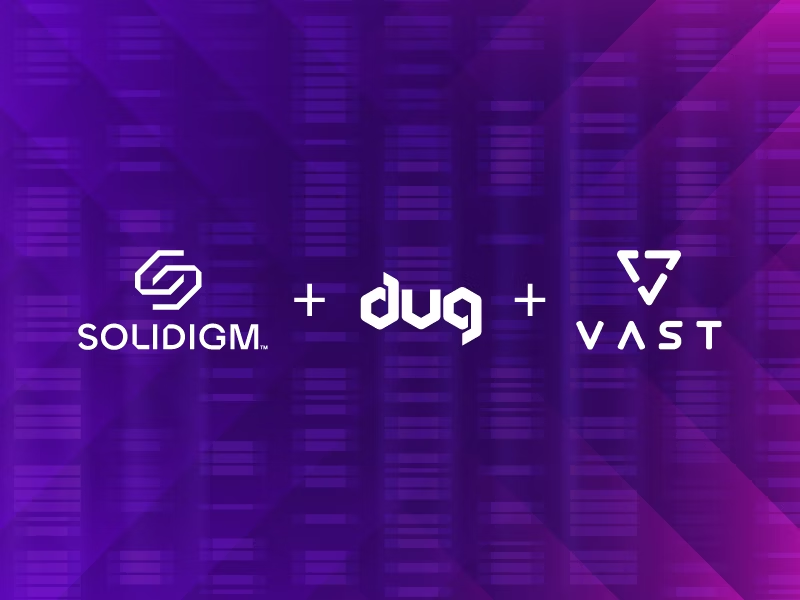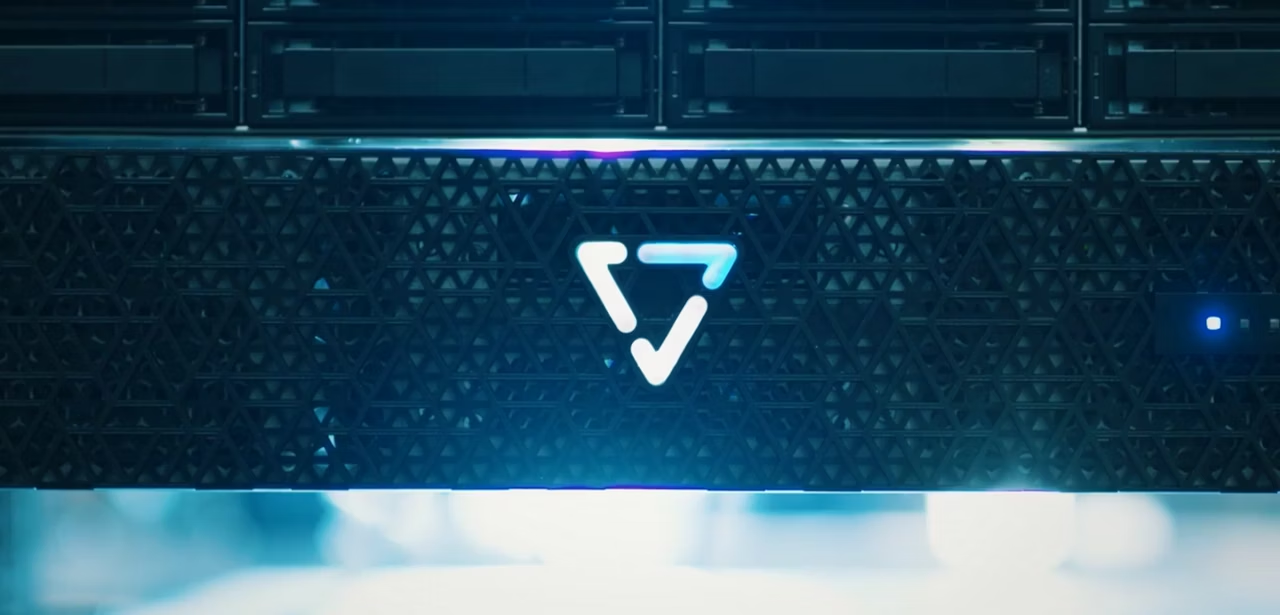The Economics of Exabyte Storage
A 10-year TCO analysis of Solidigm™ QLC SSDs with VAST Data vs. traditional HDDs with CEPH


Table of Contents
- Executive summary
- Introduction: Comparing architectural approaches for exabyte storage
- TCO modeling framework: Assumptions and supporting evidence
- Calculating effective raw capacity needs
- Data center infrastructure assumptions
- 10-year TCO analysis: HDD/CEPH vs. Solidigm SSD/VAST
- Beyond the numbers: Qualitative and strategic considerations
- Conclusion
- Disclaimers
Executive summary
The compelling economic advantages of all-flash at exabyte scale
This white paper demonstrates through rigorous, verifiable analysis that deploying a 1 exabyte (EB) usable storage solution utilizing Solidigm™ D5-P5336 high-density 122TB Quad-Level Cell (QLC) SSDs, powered by VAST Data's AI Operating System, offers a significantly lower 10-year Total Cost of Ownership (TCO) compared to a traditional approach using 30TB Hard Disk Drives (HDDs) with CEPH software. Solidigm is primarily a hardware company, so this analysis focuses exclusively on the impact of storage-centric hardware and operational expenditures (OpEx).
The Solidigm + VAST solution delivers an estimated 10-year hardware and OpEx TCO of approximately $35.19 million USD, representing a substantial 58.9% saving compared to the HDD/CEPH solution's calculated TCO of $85.62 million USD.
| Cost Category | HDD/CEPH ($M) | SSD/VAST ($M) | Difference ($M) | Difference (%) |
| Total 10-Year Hardware Cost | $40.77 | $29.06 | -$11.71 | -28.7% |
| Total 10-Year Power Cost | $13.65 | $3.13 | -$10.52 | -77.1% |
| Total 10-Year Space Cost | $31.20 | $3.00 | -$28.20 | -90.4% |
| Total 10-Year TCO | $85.62 | $35.19 | -$50.43 | -58.9% |
Table 1. Estimated 10-year TCO summary for hardware & OpEx only1 (Note: The sums are rounded)
While this analysis focuses on a 1EB deployment, the fundamental economic advantages demonstrated hold true for capacities ranging from as low as 20 Petabytes (PB) and can be extrapolated to Zettabyte (ZB) scale.
Reshaping the economics of large-scale storage
This substantial hardware and OpEx cost advantage stems from a confluence of factors inherent to the Solidigm + VAST architecture, fundamentally reshaping the economics of large-scale storage. The synergy of these elements creates a compounding benefit structure. Dramatically higher storage density, enabled by the Solidigm 122TB QLC SSD, drastically reduces the physical footprint. Fewer drives, fewer chassis, and significantly fewer data center racks are required. This initial reduction in physical hardware directly translates to lower acquisition costs for the drives themselves, and subsequently, lower power and space operational expenditures.
VAST Data's advanced software contributes compounding efficiencies. Similarity data reduction, storing only the differences in similar blocks of data, achieves significant capacity savings beyond what is physically deployed. Additionally innovative, flash-optimized erasure coding minimizes data protection overhead to industry-leading lows. Combined with VAST Data’s extended 10-year operational infrastructure lifespan and supported by VAST Data’s comprehensive warranty that includes QLC endurance, these advances eliminate the need for costly and disruptive triennial or quadrennial HDD hardware refreshes. This extended lifespan is a critical lever in the TCO calculation, as it negates a major capital expenditure cycle inherent in traditional HDD-based systems.
Expenditure savings across capital and operations
These factors can culminate in substantial savings in capital expenditure over the decade, with significant reductions in operational expenses related to power consumption and data center space utilization. These economies challenge the traditional paradigm where all-flash storage was reserved for high-performance, low-capacity tiers; this analysis indicates that for large-scale, long-term deployments, all-flash can be the more cost-effective solution for capacity-centric workloads as well. This analysis provides evidence-based support for this economic proposition.
Solidigm and VAST Data have collaborated to engineer a storage future that reduces the traditional trade-offs between performance, capacity, and cost. By leveraging Solidigm's leadership in high-density flash memory and VAST Data's revolutionary software architecture, this effort delivers a solution designed for the demands of the exabyte era. This analysis quantifies the profound economic benefits of this collaboration for organizations managing data at unprecedented scale, demonstrating a clear path towards a more efficient, sustainable, and cost-effective storage infrastructure.
Introduction: Comparing architectural approaches for exabyte storage
Organizations managing data at the exabyte scale require storage solutions that are efficient, reliable, performant, and cost-effective over the long term. This paper analyzes two distinct architectural approaches designed to meet these demands:
- Traditional HDD/CEPH: This approach is modeled using high-capacity Seagate Exos Mozaic 3+ series 30TB HDDs, managed by the widely adopted open-source CEPH software platform. This represents a common strategy for building large-scale storage pools, relying on mechanical drives housed in dense chassis and employing traditional data protection methods.
- Modern all-flash (Solidigm + VAST): This solution leverages the cutting-edge Solidigm D5-P5336 122TB QLC SSDs, representing a significant leap in storage density. These drives are integrated within VAST Data's AI Operating System, which employs a Disaggregated, Shared Everything (DASE) architecture. This architecture is specifically designed for flash media and incorporates advanced software features, including VAST's Similarity data reduction technology and highly efficient, locally decodable erasure codes. This represents a next-generation, all-flash approach engineered to overcome the performance, efficiency, and scalability limitations of legacy HDD-based systems.
Modern solutions overcome legacy limitations
The positioning of these solutions as "traditional" versus "modern" or "next-generation" frames an important narrative. The claims made for the modern solution, such as advanced data reduction and erasure coding, are substantiated by vendor-provided information and technical documentation, lending credibility to its advanced nature. Conversely, the industry-acknowledged limitations of legacy systems, when supported by industry observations or analyses, strengthen the case for exploring newer architectures.
The primary objective of this white paper is to provide a transparent and verifiable 10-year TCO comparison between these two solutions when deployed to deliver 1EB of usable storage capacity. This TCO excludes software platform costs, focusing solely on:
- Hardware acquisition
- Refresh
- Power costs
- Space costs
While the calculations focus on the 1EB mark, the relative economic benefits scale, making this analysis relevant for deployments starting from approximately 20PB and extending towards zettabyte (ZB) levels. By examining costs related to hardware acquisition, mandatory refreshes, power consumption, and data center space, this analysis aims to equip technical leaders with the quantitative data needed to make informed, strategic decisions regarding their long-term, large-scale storage infrastructure investments.
TCO modeling framework: Assumptions and supporting evidence
For transparent comparison, this TCO analysis is built upon a framework of defined assumptions, each supported by publicly available data, vendor specifications, industry reports, or direct vendor attestation where applicable. The goal is to provide a realistic, albeit specific, scenario reflecting the potential economics of deploying storage at the exabyte scale. The validity of the entire TCO model rests upon the credibility of these foundational assumptions. Therefore, each is scrutinized for its supporting evidence.
Target capacity
The analysis targets the delivery of 1EB of usable storage capacity for both the HDD/CEPH and SSD/VAST solutions. (1EB = 1000 Petabytes (PB) = 1,000,000 Terabytes (TB)).
Hardware pricing (Wholesale, Exabyte scale)
Pricing reflects anticipated costs for procurement at the exabyte level, which understandably entails significant volume discounts compared to standard enterprise or retail pricing. All prices are in USD.
- Seagate Exos Mozaic 3+ 30TB HDD: Estimated at $13.3 per TB2
Supporting Evidence: The estimated price calculation uses Seagate's reported mass-capacity segment revenue and shipped exabytes: Mass-capacity revenue (estimated at 72% of $6.551 B total revenue) is approximately $4.716 B. Mass-capacity shipped was 355EB (355 billion GB). Dividing revenue by capacity yields $4.716 B / 355 B GB ≈ $0.0133/GB, or $13.3/TB. This reflects the aggressive pricing achievable for hyperscale or exabyte-volume purchases of the latest high-capacity drives. - Solidigm D5-P5336 122TB QLC SSD: Estimated at $60 per TB
Supporting Evidence: An estimate of achievable wholesale pricing for exabyte-scale volume purchases of Solidigm 122TB QLC SSDs integrated within a VAST Data solution. This price assumes a strategic, high-volume contract pricing scenario, leveraging the specific efficiencies of the VAST Data architecture designed for QLC NAND and Solidigm focus on improving $/TB metrics with ultra-high-density drives. While representing a premium over HDDs, this $60/TB figure underscores the economic shifts possible with high-density QLC at scale within the Solidigm + VAST connection, even as it acknowledges market dynamics. The resulting TCO is sensitive to this assumption.
Hardware lifespan, warranty & refresh cycles
The assumed operational lifespan and replacement frequency differ significantly between the two solutions, driven by technology characteristics, warranty coverage, and operational best practices for maintaining performance and reliability at scale. This difference is a cornerstone of the TCO divergence and relies on contrasting the inherent properties of mechanical drives versus solid-state media, alongside vendor commitments.
- HDD/CEPH: Seagate 30TB Exos enterprise HDDs come with a standard 5-year limited warranty. However, empirical data from large-scale deployments, such as those reported by Backblaze,3 consistently shows that HDD Annualized Failure Rates (AFR) tend to increase significantly after the third to fifth year of operation, entering the "wear-out" phase of the bathtub curve. For demanding, active exabyte-scale environments where consistent performance and data availability are critical, relying on drives operating deep into their wear-out phase introduces unacceptable risk and potential performance degradation. Therefore, aligning with common enterprise practices for mission-critical systems and mitigating the impact of rising failure rates, this TCO model assumes a 4-year refresh cycle for the HDDs. This necessitates two complete hardware refreshes within the 10-year analysis period (at the end of year 4 and year 8). While some industry trends show refresh cycles lengthening, the 4-year assumption reflects a prudent approach for maintaining the health and performance of a heavily utilized exabyte-scale HDD-based system.
- Solidigm SSD/VAST: Solidigm SSDs feature a standard 5-year limited warranty. However, within the VAST infrastructure, VAST warrants the drives to operate reliably for the full 10-year duration of the TCO analysis without requiring a hardware refresh. The SSD is fully supported under VAST Data's comprehensive 10-year warranty program, which explicitly includes protection for the endurance of the Solidigm QLC SSDs used within their systems. The combination of Solidigm SSD performance, endurance, and reliability coupled with the VAST Data AI Operating System’s advanced wear-leveling algorithms and write management technique helps to enable this industry-leading 10-year system warranty. Solidigm SSDs also feature high Mean Time Between Failures (MTBF) ratings, typically 2 million hours,4 contributing to the overall system longevity. The absence of moving parts further enhances the physical durability and reliability of SSDs compared to HDDs.
HDD refresh pricing
To account for the expected decline in storage costs over time, each subsequent HDD refresh (at year 4 and year 8) is assumed to benefit from a 25% price reduction per TB compared to the previous purchase price. For example, the year 4 price per TB is 75% of the year 0 price, and the year 8 price per TB is 75% of the year 4 price.
Supporting Evidence: Historically, the cost per terabyte for HDDs has consistently decreased as technology advances and areal densities increase, although the rate of decline can fluctuate. Backblaze observed an average annual decrease of over 9% across various drive sizes between 2017 and 2022.5 A 25% price reduction over a 4-year period implies an average annual decrease of approximately 7%, which is considered plausible for large-volume procurement contracts anticipating continued technological progress in the HDD market.
The significant difference in assumed operational lifespan—requiring two full replacements for the HDD fleet versus none for the SSDs over 10 years—is a fundamental factor driving the TCO divergence. This difference is grounded in the physical nature of the technologies, observed failure rate patterns for HDDs in active use, and the specific software capabilities and warranty commitments provided by the VAST Data solution for managing QLC SSD endurance.
Storage overheads & data reduction
The efficiency with which raw storage capacity is converted into usable capacity varies significantly due to filesystem requirements, data protection needs, and data reduction technologies. These early-stage assumptions about efficiency have a profound multiplier effect, as they determine the total raw physical capacity required, which in turn influences hardware count, power consumption, and space utilization.
Filesystem metadata overhead: An overhead of 10% is assumed for filesystem metadata for both the HDD/CEPH and SSD/VAST solutions.
Supporting Evidence: Filesystem metadata (tracking file locations, attributes, permissions, etc.) consumes a portion of the raw storage capacity. The actual percentage varies based on the filesystem used, the average size of the files being stored, and other configuration factors, potentially ranging from less than 1% for very large files to over 20% for systems dominated by extremely small files. Industry guidelines and practical experience often use 10% as a reasonable rule-of-thumb for planning purposes in large, mixed-use environments. For instance, AWS FSx for ONTAP suggests 3% to 7% for typical file sizes but recommends planning with a 10% overhead (1 GiB SSD per 10 GiB data) for metadata associated with capacity pool storage. VMware vSAN ESA also allocates approximately 10% for global metadata.
Data protection overhead: The storage capacity beyond the size of the user data required to protect against drive failures differs based on the chosen protection scheme.
- HDD/CEPH: Assumed to have a data protection overhead of 12.5%.
Supporting Evidence: This overhead level reflects a common balance between resilience (protecting against multiple drive failures) and capacity efficiency in large-scale HDD-based systems using erasure coding. While specific erasure coding schemes (like k+m) determine the exact overhead, 12.5% (equivalent to an 8+1 scheme's overhead, or slightly better than a typical 14+2 scheme's 14.3%) represents a reasonable and achievable efficiency target for a well-configured CEPH cluster at exabyte scale, prioritizing usable capacity while maintaining robust data protection against common failure scenarios.
- Solidigm SSD/VAST: Assumed to have a data protection overhead of only 2.7%, achieved through VAST's use of a 146+4 locally decodable erasure coding scheme.
Supporting Evidence: VAST Data employs novel, patented locally decodable erasure codes specifically optimized for flash media. These codes allow for much wider stripes (e.g., 146 data chunks + 4 parity chunks, or 146+4) compared to traditional Reed-Solomon codes used in many HDD-based systems. Wider stripes significantly reduce the relative overhead. A 146+4 scheme results in an overhead of m/k = 4/146 ≈ 2.7%.
Data reduction efficiency: Data reduction techniques like deduplication and compression can further increase storage efficiency by reducing the amount of physical capacity needed to store logical data. The stark contrast in assumed data reduction capabilities—0% for HDD/CEPH versus 2.5:1 for Solidigm SSD/VAST—is pivotal and requires robust justification based on the performance characteristics of the underlying media.
- HDD/CEPH: Assumed to achieve 0% data reduction (a 1:1 ratio).
Supporting Evidence: While CEPH software includes capabilities for deduplication, enabling these features on HDD-based pools, especially at scale, often incurs unacceptable performance penalties. The random I/O nature of deduplication lookups and metadata management clashes with the sequential performance strengths and high latency of HDDs. The resulting fragmentation of data across the physical media severely impacts read performance (rehydration), making global deduplication impractical for active data on HDDs. Compression might offer some benefit but is often less effective on diverse datasets compared to advanced techniques and still carries a performance cost. Therefore, assuming a 1:1 ratio (no effective data reduction) is a realistic baseline for this configuration focused on usable performance. - Solidigm SSD/VAST: Assumed to achieve an average 2.5:1 data reduction ratio (DRR).
Supporting Evidence: VAST Data's platform incorporates "Similarity-Based Data Reduction," a global and granular approach that combines elements of deduplication and compression, designed to work effectively on flash media. Unlike HDDs, SSDs excel at the random I/O patterns generated by reading reduced data, minimizing the performance bottlenecks associated with deduplication on spinning disks. VAST reports an average DRR of 3:1 across its global customer base, including workloads like enterprise backup where ratios can be even higher. Specific customer deployment examples cited by VAST include 2.5:1 for seismic data, 3.5:1 for Splunk data, and 8:1 for quantitative trading data. The 2.5:1 assumption used in this model is slightly more conservative than VAST's claimed average but aligns with reported results for certain data types and represents a credible efficiency expectation for a large, mixed-workload exabyte environment leveraging VAST and Solidigm technology. This reduction is achieved without performance impact due to VAST's flash-native architecture.
The combination of VAST's efficient erasure coding (low overhead) and its effective data reduction technology results in a notable compounding effect on overall storage efficiency. The end result is the Solidigm + VAST solution requires significantly less raw physical capacity to deliver the target 1EB of usable storage compared to the HDD/CEPH approach.
Calculating effective raw capacity needs
Based on the overheads and data reduction assumptions, the total raw physical capacity required for each solution is estimated as follows:
- HDD/CEPH:
Capacity needed before protection/reduction (after 10% FS overhead): 1EB / (1 - 0.10) = 1.111EB
Raw capacity required (after 12.5% protection overhead, 1:1 DRR): 1.111EB * (1 + 0.125) = 1.111EB * 1.125 = 1.250EB - Solidigm SSD/VAST:
Capacity needed before protection/reduction (after 10% FS overhead): 1EB / (1 - 0.10) = 1.111EB
Capacity needed after protection (2.7% overhead): 1.111EB * (1 + 0.027) = 1.141EB
Raw capacity required (after 2.5:1 DRR): 1.141EB / 2.5 = 0.456EB
| Parameter | HDD/CEPH | Solidigm SSD + VAST |
| Usable Capacity Target (EB) | 1.000 | 1.000 |
| Filesystem Overhead Factor | 1 / (1 - 0.10) | 1 / (1 - 0.10) |
| Capacity After FS Overhead (EB) | 1.111 | 1.111 |
| Data Protection Overhead Factor | 1 + 0.125 | 1 + 0.027 |
| Capacity After Protection (EB) | 1.250 | 1.141 |
| Data Reduction Ratio | 1:1 | 2.5:1 |
| Calculated Raw Capacity Required (EB) | 1.250 | 0.456 |
Table 2. Effective vs. raw drive capacity calculation
This calculation illustrates the efficiency difference: the Solidigm + VAST solution requires approximately 2.7 times less raw physical storage (1.250EB / 0.456EB) than the HDD/CEPH solution to deliver the same 1EB of usable capacity. This fundamental difference in required physical hardware drives downstream reduction on component counts, capital costs, power consumption, and space utilization.

Figure 1. Calculated raw capacity for SSD vs HDD exabyte storage
Determining hardware scale
The calculated raw capacity requirements translate into the following component counts for the initial solution deployment:
- HDD/CEPH:
Number of 30TB HDDs: 1.250EB * (1,000,000 TB/EB) / 30 TB/drive = 41,666.6... → 41,667 drives
Assumed chassis: A common high-density HDD platform is a Supermicro 4U chassis capable of holding 90 x 3.5" drives6.
Number of chassis: 41,667 drives / 90 drives/chassis = 462.96... → 463 chassis - Solidigm SSD/VAST:
Number of Solidigm 122TB SSDs: 0.456EB * (1,000,000 TB/EB) / 122.88 TB/drive = 3,737.7... → 3,738 drives
Assumed chassis: VAST Data utilizes hardware from many manufacturers, including AIC’s custom-designed dense enclosures like the 1U Ceres platform. This analysis assumes a 1U Ceres chassis7 configuration holding 22 x 122TB SSDs. This yields a raw capacity of 22 * 122TB = 2684TB per 1U chassis.
Number of Chassis: 3,738 drives / 22 drives/chassis = 169.9... → 170 chassis
| Component | HDD/CEPH Solution | Solidigm SSD/VAST Solution |
| Seagate 30TB HDD | 41,667 | 0 |
| Solidigm D5-P5336 122TB SSD | 0 | 3,738 |
| 4U 90-Bay HDD Chassis (Est.) | 463 | 0 |
| 1U VAST Ceres SSD Chassis (Est.) | 0 | 170 |
Table 3. Hardware component summary
Table 3 highlights the reduction in the number of physical components required by the Solidigm + VAST solution—approximately 11 times fewer drives and 2.7 times fewer chassis. These figures, derived directly from the raw capacity calculations and vendor-specified component capacities, make the physical scale difference concrete and easily understandable.
Data center infrastructure assumptions
Standard assumptions for a modern, reasonably efficient data center environment are used.
- Power cost: $0.15 USD per kWh
Supporting evidence: This rate falls within the spectrum of commercial electricity costs across the US, which vary significantly by region.8 While the US average commercial rate might be slightly lower (e.g., ~12-13 cents/kWh in recent EIA data), $0.15/kWh represents a plausible rate for certain high-cost areas or reflects retail colocation pricing structures. Wholesale prices can be much lower but are highly volatile. - Power usage effectiveness (PUE): 1.4
Supporting evidence: PUE measures the ratio of total facility power to IT equipment power. A PUE of 1.0 is the theoretical ideal. The industry average PUE has hovered around 1.55-1.56 in recent years, according to Uptime Institute surveys.9 However, newer, efficient facilities often achieve PUEs of 1.3 or better. A PUE of 1.4 represents an efficient but achievable target for a large-scale deployment in a modern data center. - Space cost:
HDD/CEPH & SSD/VAST: $5000 USD per rack per month (for high-power 40kW racks with enhanced cooling, reflecting new build costs)
Supporting evidence: Colocation costs vary widely. While standard racks might be cheaper, high-density racks capable of supporting 40kW+ (like those needed for densely packed SSD/VAST systems and increasingly common for GPU infrastructure) require significantly more power infrastructure and advanced cooling (e.g., rear door heat exchangers), commanding premium pricing. Assuming a new data center build standardizes on high-power racks to accommodate future needs including GPUs, a cost of $5000/month for such specialized infrastructure is considered a plausible estimate reflecting the necessary investment in power and cooling capacity, particularly in prime markets or for comprehensive service agreements. - Standard rack specifications: The analysis assumes standard 19-inch EIA racks with the following typical characteristics:
Height: 42U
Depth: Approx. 1000 mm - 1200 mm
Static weight capacity: 2000 - 3000 lbs (907 - 1363 kg). A capacity of 1363 kg (3000 lbs) is used for calculations.
Power capacity: Assumed at 40 kW per rack
Infrastructure footprint analysis
Based on the hardware scale and infrastructure assumptions, the physical footprint and power requirements are estimated as follows:
- HDD/CEPH:
Chassis: 463 x 4U Supermicro 90-bay
Total rack unit space: 463 chassis * 4U/chassis = 1852 rack units
Power per drive (Average): 6.5 Watts, derived from typical enterprise HDD specifications10
Power per chassis (Average): Power for drives + chassis overhead
Drive power = 90 drives * 6.5 W/drive = 585 W. Chassis overhead is 1000 W
Total IT power per chassis ≈ 585 W + 1000 W = 1585 W or 1.585 kW
Total IT power (Average): 463 chassis * 1.585 kW/chassis ≈ 733.855 kW
Weight per drive: 0.695 kg
Weight per chassis (Populated): Chassis empty weight approx. 68 kg. Drive weight = 90 * 0.695 kg = 62.55 kg
Total populated weight ≈ 68 kg + 62.55 kg = 130.55 kg
Racks needed: Determined by the most restrictive constraint (Space, power, or weight)
Space limit: 42 U rack / 4 U/chassis = 10.5 → 10 chassis per rack. Racks needed = 463 / 10 = 46.3 → 47 racks
Power limit (40 kW/rack): 40 kW/rack / 1.585 kW/chassis = 25.23 → 25 chassis per rack. Racks needed = 463 / 25 = 18.52 → 19 racks
Weight limit (1363 kg/rack): Assume rack itself weighs ~150 kg. Available load = 1363 kg - 150 kg = 1213 kg. Max chassis per rack = 1213 kg / 130.55 kg/chassis = 9.29 → 9 chassis per rack. Racks needed = 463 / 9 = 51.44 → 52 racks
Conclusion: The deployment remains weight-limited to 9 chassis per rack, requiring 52 racks
Total rack power (incl. PUE): 52 racks * (9 chassis/rack * 1.585 kW/chassis) * 1.4 PUE = 52 * 14.265 kW * 1.4 ≈ 1038.56 kW
Average kW per Rack (IT): 14.265 kW (well within the 40kW limit)
Average weight per rack (Populated): 9 chassis * 130.55 kg/chassis + 150 kg (rack) ≈ 1175 kg + 150 kg = 1325 kg (within 1363 kg limit)
- Solidigm SSD/VAST:
Chassis: 170 x 1U VAST Ceres
Total U space: 170 chassis * 1 U/chassis = 170 U
Power per chassis (Active): Assumed at 1.0 kW
Total IT power (Active): 170 chassis * 1.0 kW/chassis = 170 kW
Weight per Cchassis (Populated): 29.5 kg
Racks needed: Determined by the most restrictive constraint (Space, power, or weight)
Space limit: 42 U rack / 1 U/chassis = 42 chassis per rack. Racks needed = 170 / 42 = 4.05 → 5 racks
Power limit (40 kW/rack): 40 kW/rack / 1.0 kW/chassis = 40 chassis per rack. Racks needed = 170 / 40 = 4.25 → 5 racks
Weight limit (1363 kg/rack): Available load = 1213 kg. Max chassis per rack = 1213 kg / 29.5 kg/chassis = 41.1 → 41 chassis per rack. Racks needed = 170 / 41 = 4.15 → 5 racks
Conclusion: The deployment remains constrained by Power/Weight/Space to 5 racks
Total rack power (incl. PUE): 5 racks * (170 chassis / 5 racks * 1.0 kW/chassis) * 1.4 PUE = 5 * (34 chassis/rack * 1.0 kW/chassis) * 1.4 = 5 * 34 kW * 1.4 = 238 kW
Average kW per rack (IT): 170 kW / 5 racks = 34 kW. (Within the 40 kW limit)
Average weight per rack (Populated): 34 chassis * 29.5 kg/chassis + 150 kg (rack) = 1003 kg + 150 kg = 1153 kg (well within 1363 kg limit)
| Parameter | HDD/CEPH | Solidigm SSD/VAST | Unit |
| Total Raw Capacity Required | 1.250 | 0.456 | EB |
| Total Drive Count | 41,667 | 3,738 | Drives |
| Total Chassis Count | 463 | 170 | Chassis |
| Chassis U Height | 4 | 1 | U |
| Total U Space | 1,852 | 170 | U |
| Total IT Power (Average/Active) | 733.86 | 170 | kW |
| Racks Needed | 52 | 5 | Racks |
| Total Facility Power (incl. 1.4 PUE) | 1038.56 | 238 | kW |
| Avg. IT kW per Rack (Populated) | 14.27 | 34.0 | kW/Rack |
| Avg. Weight per Rack (Populated) | 1325 | 1153 | kg/Rack |
Table 4. Infrastructure footprint comparison estimate
The infrastructure footprint analysis quantifies the dramatic physical consolidation enabled by the Solidigm + VAST solution. Driven by the higher density of the Solidigm 122TB SSDs and the efficiency gains from VAST's software, the all-flash approach requires over 10 times fewer racks (5 racks vs. 52 racks). The increased chassis overhead for HDDs widens the gap in total facility power consumption (238 kW for SSD/VAST vs. 1038.56 kW for HDD/CEPH). These differences in physical and electrical footprints, derived from component specifications and industry-standard data center metrics, are primary drivers of the OpEx variations in the TCO.

Figure 2. Total racks needed for SSD vs HDD exabyte storage
Exclusions
The following cost categories are intentionally excluded from the TCO calculation:
- Software support costs: Costs associated with CEPH support contracts or VAST Data software licenses and support are not included.
- Networking infrastructure costs: The costs of network switches, cables, and optics required to connect the storage nodes are assumed to represent an immaterial difference between the two solutions at this scale and are excluded.
- Labor costs: Costs associated with initial deployment, ongoing maintenance, and hardware refreshes are not explicitly quantified but are discussed qualitatively.
10-year TCO analysis: HDD/CEPH vs. Solidigm SSD/VAST
This section calculates and compares the 10-year TCO for both storage solutions, aggregating the costs of hardware acquisition and refreshes, power consumption, and data center space based on the framework established in the previous section. The analysis demonstrates how the initial higher capital expenditure for the Solidigm SSD/VAST solution is overcome by significant long-term savings in refresh costs and operational expenditures.
Hardware acquisition & refresh costs
- HDD/CEPH estimated costs:
Initial drive cost (Year 0): 1.250 EB * $13.3/TB * 1,000,000 TB/EB = $16,625,000
Initial chassis cost (Year 0): 463 chassis * $5,000/chassis (estimated) = $2,315,000
Year 0 Total: $18,940,000
Year 4 HDD refresh (drives only, 25% price reduction): 1.250 EB * ($13.3*0.75)/TB * 1,000,000 TB/EB = $12,468,750
Year 8 HDD Refresh (drives only, further 25% price reduction): 1.250 EB * ($13.30.750.75)/TB * 1,000,000 TB/EB = $9,351,562.50
Total 10-Year Hardware Cost (HDD/CEPH): $18,940,000 + $12,468,750 + $9,351,562.50 ≈ $40.77M - Solidigm SSD/VAST estimated costs:
Initial drive cost (Year 0): 0.456 EB * $60/TB * 1,000,000 TB/EB = $27,360,000
Initial chassis cost (Year 0): 170 chassis * $10,000/chassis (estimated, reflecting integrated system nature) = $1,700,000
Year 0 Total: $29,060,000
No refreshes assumed over 10 years.
Total 10-year hardware cost (SSD/VAST): $29.06M
| Cost Component | HDD/CEPH Cost ($M) | Solidigm SSD/VAST Cost ($M) |
| Year 0 (Initial Drives) | $16.63 | $27.36 |
| Year 0 (Initial Chassis - Est.) | $2.32 | $1.70 |
| Year 0 Total | $18.95 | $29.06 |
| Year 4 (HDD Refresh - Drives Only) | $12.47 | $0.00 |
| Year 8 (HDD Refresh - Drives Only) | $9.35 | $0.00 |
| Total 10-Year Hardware Cost | $40.77 | $29.06 |
Table 5. 10-year estimated hardware investment comparison
The initial hardware investment for the Solidigm + VAST solution is estimated to be approximately 53% higher than the HDD/CEPH solution. However, due to two full drive refreshes for the HDD solution (adding ~$21.8M), its total 10-year hardware cost is approximately 40% higher than the all-flash solution. This illustrates the critical impact of lifecycle assumptions: the initial lower expense for HDDs becomes more expensive over the decade due to repeated replacement cycles, a cost that can be avoided by the longer-lifespan SSD solution backed by VAST Data’s 10-year warranty.

Figure 3. Total 10-year hardware cost for SSD vs HDD exabyte storage
Operational Expenditure — Power Consumption Estimates
- HDD/CEPH:
Total facility power (average): 1038.56 kW (from Table 4)
Annual energy consumption: 1038.56 kW * 24 hours/day * 365 days/year = 9,098,193.6 kWh
Annual power cost: 9,098,193.6 kWh * $0.15/kWh = $1,364,729.04
10-year power cost (HDD/CEPH): $1,364,729.04 * 10 ≈ $13.65M - Solidigm SSD/VAST:
Total facility power (active): 238 kW (from Table 4)
Annual energy consumption: 238 kW * 24 hours/day * 365 days/year = 2,085,120 kWh
Annual power cost: 2,085,120 kWh * $0.15/kWh = $312,768
10-year power cost (SSD/VAST): $312,768 * 10 ≈ $3.13M
| Parameter | HDD/CEPH | Solidigm SSD/VAST | Unit |
| Total IT Power (Avg/Active) | 733.86 | 170 | kW |
| PUE Factor | 1.4 | 1.4 | - |
| Total Facility Power (kW) | 1038.56 | 238 | kW |
| Annual Energy Consumption | 9,098,194 | 2,085,120 | kWh |
| Cost per kWh | $0.15 | $0.15 | USD/kWh |
| Annual Power Cost | $1,364,729 | $312,768 | USD |
| Total 10-Year Power Cost ($M) | $13.65 | $3.13 | USD M |
Table 6. 10-year estimated power cost comparison
The Solidigm + VAST solution's lower component count and higher energy efficiency result in a 77% reduction in total facility power consumption compared to the HDD/CEPH system. Over 10 years, this translates into over $10.5 million in estimated direct power cost savings. This operational saving is a direct consequence of the superior density and efficiency of SSD technology and the VAST architecture.

Figure 4. Total 10-year power cost for SSD vs HDD exabyte storage
Operational expenditure — Data center space estimates
- HDD/CEPH:
Rack count: 52 racks (from Table 4)
Annual space cost: 52 racks * $5,000/rack/month * 12 months/year = $3,120,000
10-year space cost (HDD/CEPH): $3,120,000 * 10 = $31.20M - SSD/VAST:
Rack count: 5 racks (from Table 4)
Annual space cost: 5 racks * $5,000/rack/month * 12 months/year = $300,000
10-year space cost (SSD/VAST): $300,000 * 10 = $3.00M
| Parameter | HDD/CEPH | Solidigm SSD/VAST | Unit |
| Rack Count | 52 | 5 | Racks |
| Cost per Rack per Month | $5,000 | $5,000 | USD |
| Annual Space Cost | $3,120,000 | $300,000 | USD |
| Total 10-Year Space Cost ($M) | $31.20 | $3.00 | USD M |
Table 7. 10-year space cost comparison
The SSD/VAST solution's extreme density (5 racks vs. 52 racks) yields an estimated $28.2 million saving in space costs over 10 years. This highlights how the physical footprint, driven by storage density, becomes a major economic differentiator in long-term, large-scale deployments, especially when using premium data center rack space.
Total cost of ownership synthesis
- HDD/CEPH 10-year TCO: $40.77M (Hardware) + $13.65M (Power) + $31.20M (Space) = $85.62M
- SSD/VAST 10-year TCO: $29.06M (Hardware) + $3.13M (Power) + $3.00M (Space) = $35.19M
- Estimated hardware + OpEx TCO Savings with SSD/VAST: $85.62M - $35.19M = $50.43M
- Percentage savings: ($50.43M / $85.62M) * 100% ≈ 58.9%
| Cost Category | HDD/CEPH ($M) | Solidigm/VAST ($M) | Difference ($M) | Difference (%) |
| Total 10-Year Hardware Cost | $40.77 | $29.06 | -$11.71 | -28.7% |
| Total 10-Year Power Cost | $13.65 | $3.13 | -$10.52 | -77.1% |
| Total 10-Year Space Cost | $31.20 | $3.00 | -$28.20 | -90.4% |
| Total 10-Year TCO | $85.62 | $35.19 | -$50.43 | -58.9% |
Table 8. Comprehensive estimated 10-year TCO savings summary hardware & OpEx only (Note: The sums are rounded)
The comprehensive 10-year TCO analysis, reflecting increased HDD chassis power overhead, further amplifies the economic advantage of the Solidigm + VAST all-flash solution. The higher power cost for the HDD/CEPH solution, combined with its large space footprint, increases its TCO. While HDDs may offer a lower initial cost per terabyte, the cumulative expenses associated with their lower efficiency, shorter refresh cycles, and higher power and space demands make them a more expensive proposition over a 10-year horizon at exabyte scale.
Beyond the numbers: Qualitative and strategic considerations
While the 10-year TCO analysis provides a compelling quantitative comparison, qualitative factors also differentiate the two solutions and impact their overall value proposition and strategic fit for modern data centers. These aspects, though not directly factored into the TCO calculation above, are critical for a holistic evaluation, often translating into strategic advantages that extend beyond direct cost savings.
Performance disparity — Accelerating insights and applications
The fundamental difference in media (mechanical spinning disk vs. flash) results in orders-of-magnitude performance differences. HDDs offer millisecond-level latency and IOPS typically in the low hundreds per drive. Solidigm SSDs, particularly NVMe-based QLC drives in an optimized system like VAST Data's, deliver microsecond-level latency and vastly higher IOPS and bandwidth.4
- Impact: The performance advantage of the Solidigm + VAST all-flash solution translates into tangible benefits: faster application response times, reduced batch processing windows, the ability to consolidate more diverse and demanding workloads onto a single platform, and quicker time-to-insight from data analytics and AI initiatives. For businesses where data velocity and analytical speed are competitive differentiators, this performance uplift can be invaluable.
Operational burden — Simplicity, reliability, and reduced effort
The Solidigm + VAST solution involves significantly fewer physical components (drives, chassis, racks) compared to the HDD/CEPH setup. SSDs generally exhibit lower annualized failure rates (AFR) than HDDs, especially as HDDs age past their initial years of service.3 The elimination of hardware refreshes for the SSD/VAST solution over the 10-year period contrasts sharply with the two full, disruptive, and labor-intensive refreshes required for the HDD fleet.
- Impact: The Solidigm + VAST solution offers reduced operational complexity and administrative overhead. Fewer failures translate to less reactive maintenance, and the elimination of mandatory refreshes frees valuable IT resources, reduces risk associated with large-scale hardware swaps, and enhances overall system availability and predictability. This can lead to lower staffing requirements for storage management or allow existing staff to focus on more strategic initiatives.
Environmental concerns — A 10-year lifecycle view
Environmental considerations are important for organizations and their customers.
- Operational power: As quantified (Table 6), the Solidigm + VAST solution consumes approximately 77% less facility power over 10 years compared to the HDD solution. This translates directly to significantly lower Scope 2 operational carbon emissions.
- Embodied carbon & e-waste: While the initial manufacturing of an SSD might have a higher carbon footprint per unit than an HDD, the Solidigm + VAST solution requires fewer drives (3,738 SSDs vs. 41,667 HDDs) at initial deployment. Furthermore, the HDD solution undergoes two full refreshes, meaning three sets of drives are manufactured and disposed over 10 years, versus only one set for the SSD solution. This can result in less e-waste and lower cumulative manufacturing emissions for the all-flash approach.
- Material use: The higher density of SSDs means less raw material is consumed to deliver the same usable capacity.
- Impact: A 10-year lifecycle analysis favors the Solidigm + VAST solution from a sustainability perspective due to significantly lower operational energy consumption, avoidance of manufacturing emissions and e-waste from HDD replacements, and reduced use of infrastructure materials.
Unlocking potential — Resource reallocation and AI acceleration
The efficiencies of the all-flash solution can free up critical data center resources.
- Power and space savings: The calculated savings of approximately 800 kW of facility power (1038.56 kW for HDD vs. 238 kW for SSD) and 47 data center racks (Table 4) represent valuable resources. These resources can be reallocated to power and house other critical IT infrastructure, such as GPU servers for AI/ML workloads, without needing to expand the data center footprint or power capacity. The massive space cost savings ($28.2M over 10 years) and power cost savings (>$10.5M) further underscore the potential for reinvestment or cost avoidance.
- AI/GPU acceleration: High-performance computing, particularly AI and machine learning, demands high-throughput, low-latency storage to keep expensive GPU resources fully utilized. Traditional HDD-based storage can become a significant bottleneck, starving GPUs of data and reducing the ROI on AI investments. The performance characteristics of the Solidigm + VAST all-flash solution are well-suited to these demanding workloads.
- Impact: The Solidigm + VAST solution acts not only as a cost-effective storage platform but also as an enabler for greater efficiency and performance throughout the data center. The ability to repurpose power and space for revenue-generating or strategically critical applications like AI, rather than consuming them with less efficient storage, presents a significant indirect economic benefit.
| Factor | HDD/CEPH Assessment | Solidigm SSD/VAST Assessment |
| Performance | ||
| Latency | Millisecond-level latency. | Microsecond-level latency. |
| IOPS | Low IOPS (100-200 range per drive). | Very high IOPS (100k+ per system). |
| Bandwidth/Throughput | Moderate sequential throughput. | Very high sequential throughput. |
| Reliability & Maintenance | ||
| Component Count & Failure Points | Very high drive/chassis count. | Significantly lower drive/chassis count. |
| Drive Failure Rates (AFR) | Higher AFR (1-3%+ typical, increases with age). | Generally lower AFR (~0.5-1%). |
| Hardware Refreshes | Requires two disruptive, large-scale refreshes. | No hardware refreshes required (10-year warranty). |
| Maintenance Effort / FTE Req. | High due to component count, failure rates, refreshes. | Significantly lower due to fewer components, lower AFR, and no refreshes. |
| 10-Year Environmental Profile | ||
| Embodied Carbon (Lifecycle) | Lower initial per-drive CO2e, but 3x manufacturing cycles due to refreshes. | Higher initial per-drive CO2e, but 1x manufacturing cycle; lower raw capacity needed. |
| Operational Power | Very high-power consumption due to drive mechanics, large component count, and high chassis overhead. | Significantly lower power consumption (~77% less) due to flash efficiency and density. |
| E-Waste | Generates substantial e-waste from two full hardware refreshes. | Avoids refresh-related e-waste. |
| Material Use | Requires more raw materials due to lower density. | Requires fewer raw materials due to extreme density. |
| Strategic Impact | ||
| Resource Reallocation | Consumes significantly more space ($28M+ higher cost) and power (~800 kW more), limiting expansion. | Frees up substantial power (~800 kW) and especially space (47 racks, $28M+ cost saving) for reallocation. |
| AI/GPU Acceleration | Performance limitations can bottleneck GPUs. | High performance effectively feeds GPUs, accelerating AI/ML. |
Table 9. Qualitative factor comparison
Conclusion
The analysis presented in this whitepaper provides a data-driven comparison of the 10-year Total Cost of Ownership (TCO), focusing on hardware and operational expenditures, for deploying 1 exabyte of usable storage using two distinct technological approaches.
Based on the assumptions and calculations within this framework, the findings favor the modern all-flash solution. Solidigm D5-P5336 122TB QLC SSDs combined with the VAST Data AI Operating System demonstrate a lower 10-year TCO, calculated at $35.19 million USD, compared to $85.62 million USD for the traditional high-capacity HDD solution managed by CEPH. This represents an estimated savings of $50.43 million USD, or approximately 58.9%, over the decade.
This compelling economic advantage is driven by a confluence of factors inherent to the Solidigm + VAST architecture:
- Superior storage efficiency: VAST Data's advanced data reduction, and highly efficient erasure coding, combined with the high density of Solidigm 122TB QLC SSDs, meaningfully reduces the required raw physical capacity (0.456 EB vs. 1.250 EB). This foundational efficiency means fewer drives, chassis, and racks from the outset.
- Elimination of hardware refreshes: VAST Data’s 10-year warranty and longevity engineered into the Solidigm + VAST solution helps avoid over $21.8 million in HDD replacement costs and the associated operational disruption that could be incurred with the HDD/CEPH solution's 4-year refresh cycle.
- Reduced operational expenditures: The all-flash system's lower component count and power-efficient design deliver consequential ongoing savings in data center power (>$10.5M saved) and space (>$28.2M saved) over the 10-year deployment period.
Beyond the TCO reduction, the Solidigm + VAST solution offers critical qualitative and strategic advantages including superior performance for AI/ML workloads, lower maintenance burdens, increased reliability, and a stronger long-term sustainability profile. The power and space savings also offer valuable opportunities for resource reallocation within the data center, potentially deferring or avoiding costly facility expansions.
Crucially, this analysis suggests that the long-held assumption of needing a separate, lower-cost HDD tier for "colder" data may no longer be economically justified when considering a 10-year horizon, particularly in new data center builds or for large-scale capacity expansions. The cumulative cost of managing less efficient, shorter-lived HDD infrastructure at scale can outweigh its initial acquisition cost benefits. The paradigm is shifting, suggesting that a single, high-density, efficient all-flash tier can be the most economical approach for a wider range of data, not just performance-critical applications.
For organizations planning and investing in storage infrastructure at the exabyte scale, the transition to an all-flash architecture powered by Solidigm QLC SSDs and VAST Data software represents a fundamentally more economical, efficient, and strategically advantageous path forward. The evidence indicates that the Solidigm + VAST solution delivers not only substantial cost savings, but also the performance, reliability, and scalability required to meet the challenges to unlock the opportunities of the data-driven future.
About the Author
Dave Sierra is a Product Marketing Analyst at Solidigm, where he focuses on solving the infrastructure efficiency challenges that face today's data centers.
Notes
- Hardware and software configurations are shown in detail throughout this paper. The estimates provided to you in this paper are for information purposes only. Some results have been estimated or simulated using internal Solidigm or other analysis or architecture simulation or modeling. Tests document performance of components on a particular test, in specific systems.
- Seagate FY2024 10-K report, a generally accepted method for deriving storage price points.
- The Register: Backblaze sees drive failure rates increase. https://www.theregister.com/2024/08/06/backblaze_sees_drive_failure_rates/
- See Solidigm D5-P5336 product specifications @ https://www.solidigm.com/products/data-center/d5/p5336.html
- Backblaze Blog: Hard drive cost per gigabyte trends (through Nov 2022). https://www.backblaze.com/blog/hard-drive-cost-per-gigabyte/
- Supermicro 90-drive 4U JBOD https://www.supermicro.com/products/archive/chassis/sc946ed-r2kjbod
- VAST Data Ceres Storage Platform https://www.vastdata.com/blog/ceres-storage-platform-concept
- Clean Energy Buyers Association: Electricity Price Impacts Report.(https://cebuyers.org/wp-content/uploads/2025/02/CEBA_Electricity-Price-Impacts-of-Technology-Neutral-Tax-Incentives-With-Incremental-Electricity-Demand-From-Data-Centers_February-2025.pdf
- Uptime Institute: Global Data Center Survey 2024.(https://datacenter.uptimeinstitute.com/rs/711-RIA-145/images/2024.GlobalDataCenterSurvey.Report.pdf?version=0
- Seagate Exos M ST30000NM004K specifications https://www.seagate.com/products/enterprise-drives/exos/exos-m/
Disclaimers
The estimates provided to you in this paper are for information purposes only. Some results have been estimated or simulated using internal Solidigm or other analysis or architecture simulation or modeling. Tests document performance of components on a particular test, in specific systems.
Features and benefits of Solidigm technologies depend on system configuration and may require enabled hardware, software, or service activation. Differences in hardware, software, or configuration will affect actual performance. Your results may vary.
Solidigm does not control or audit third-party data. You should consult other sources of information to evaluate accuracy and/or performance as you consider your purchase. Performance results are based on testing as of dates shown in the configurations and may not reflect all publicly available updates. See configuration disclosure for details.
Nothing herein is intended to create any express or implied warranty, including without limitation, the implied warranties of merchantability, fitness for a particular purpose, and non-infringement, or any warranty arising from course of performance, course of dealing, or usage in trade.





